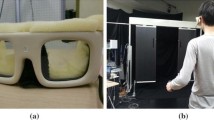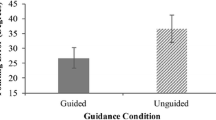Abstract
In a series of experiments, we tested the hypothesis that severely degraded viewing conditions during locomotion distort the perception of distance traveled. Some research suggests that there is little-to-no systematic error in perceiving closer distances from a static viewpoint with severely degraded acuity and contrast sensitivity (which we will refer to as blur). However, several related areas of research—extending across domains of perception, attention, and spatial learning—suggest that degraded acuity and contrast sensitivity would affect estimates of distance traveled during locomotion. In a first experiment, we measured estimations of distance traveled in a real-world locomotion task and found that distances were overestimated with blur compared to normal vision using two measures: verbal reports and visual matching (Experiments 1 a, b, and c). In Experiment 2, participants indicated their estimate of the length of a previously traveled path by actively walking an equivalent distance in a viewing condition that either matched their initial path (e.g., blur/blur) or did not match (e.g., blur/normal). Overestimation in blur was found only when participants learned the path in blur and made estimates in normal vision (not in matched blur learning/judgment trials), further suggesting a reliance on dynamic visual information in estimates of distance traveled. In Experiment 3, we found evidence that perception of speed is similarly affected by the blur vision condition, showing an overestimation in perception of speed experienced in wheelchair locomotion during blur compared to normal vision. Taken together, our results demonstrate that severely degraded acuity and contrast sensitivity may increase people’s tendency to overestimate perception of distance traveled, perhaps because of an increased perception of speed of self-motion.







Similar content being viewed by others
Notes
These results contrast with on-average accurate dynamic updating of distance when walking without vision after static viewing—often referred to as blind walking (Loomis, Silva, Fujita, & Fukusima, 1992; Rieser, Ashmead, Taylor, & Youngquist, 1990)—which may be due to the typically shorter distances used, or the nature of the explicit visually-directed walking task to a known target.
Here, the overestimation in blur occurred only after estimates were made with normal vision. It could be that those who walked with blur first learned that visual information was unreliable and weighted body-based cues for distance traveled more heavily, leading to more accurate judgments. This effect is consistent with the general finding that distance estimates after walking without vision are more accurate than when vision is added (e.g., Sun, Campos, Young, Chan, & Ellard, 2004).
References
Barhorst-Cates, E. M., Rand, K. M., & Creem-Regehr, S. H. (2017). Let me be your guide: physical guidance improves spatial learning for older adults with simulated low vision. Experimental Brain Research, 235(11), 3307–3317.
Bochsler, T. M., Legge, G. E., Gage, R., & Kallie, C. S. (2013). Recognition of ramps and steps by people with low vision. Investigative Ophthalmology & Visual Science, 54(1), 288–294.
Bremmer, F., & Lappe, M. (1999). The use of optical velocities for distance discrimination and reproduction during visually simulated self motion. Experimental Brain Research, 127, 33–42.
Campos, J. L., Butler, B. C., & Bülthoff, H. H. (2012). Multisensory integration in the estimation of walked distances. Experimental Brain Research, 218(4), 551–565.
Campos, J. L., Byrne, P., & Sun, H. J. (2010). The brain weights body-based cues higher than vision when estimating walked distances. European Journal of Neuroscience, 31(10), 1889–1898.
Frenz, H., Bremmer, F., & Lappe, M. (2003). Discrimination of travel distances from `situated’ optic flow. Vision Research, 43, 2173–2183.
Frenz, H., & Lappe, M. (2005). Absolute travel distance from optic flow. Vision Research, 45, 1679–1692.
Frenz, H., Lappe, M., Kolesnik, M., & Bülhrmann, T. (2007). Estimation of travel distance from visual motion in virtual environments. ACM Transactions on Applied Perception, 4(1), 1–18.
Gibson, J. J. (1950). The perception of visual surfaces. American Journal of Psychology, 63, 367–384.
Glasauer, S., Schneider, E., Grasso, R., & Ivanenko, aY. P. (2007). Space-time relativity in self-motion reproduction. Journal of Neurophysiology, 97, 451–461.
Glasauer, S., Stein, A., Günther, A. L., Flanagin, V. L., Jahn, K., & Brandt, T. (2009). The effect of dual tasks in locomotor path integration. Annals of the New York Academy of Sciences, 1164(1), 201–205.
Harris, L. R., Herpers, R., Jenkin, M., Allison, R. S., Jenkin, H., Kapralos, B., Felsner, S. (2012). The relative contributions of radial and laminar optic flow to the perception of linear self-motion Harris et al. Journal of Vision, 12(10), 7–7.
Kalia, A. A., Schrater, P. R., & Legge, G. E. (2013). Combining path integration and remembered landmarks when navigating without vision. PLoS ONE, 8(9), e72170.
Kuyk, T., & Elliott, J. L. (1999). Visual factors and mobility in persons with age-related macular degeneration. Journal of Rehabilitation Research and Development, 36(4), 303–312.
Lappe, M., Jenkin, M., & Harris, L. R. (2007). Travel distance estimation from visual motion by leaky path integration. Experimental Brain Research, 180(1), 35–48.
Lappin, J. S., Shelton, A. L., & Rieser, J. J. (2006). Environmental context influences visually perceived distance. Perception & Psychophysics, 68(4), 571–581.
Larish, J. F., & Flach, J. M. (1990). Sources of optical information useful for perception of speed of rectilinear self-motion. Journal of Experimental Psychology: Human Perception and Performance, 16(2), 295.
Lee, D. N. (1976). A theory of visual control of braking based on information about time-to-collision. Perception, 5, 437–459.
Legge, G. E., Gage, R., Baek, Y., & Bochsler, T. M. (2016). Indoor spatial updating with reduced visual information. PLoS One, 11(3), e0150708. https://doi.org/10.1371/journalpone.0150708.
Loomis, J. M., Silva, J. A. D., Fujita, N., & Fukusima, S. S. (1992). Visual space perception and visually directed action. Journal of Experimental Psychology: Human Perception and Performance, 18(4), 906–921.
Magel, S. G., & Sadalla, E. K. (1980). The perception of traversed distance. Environment and Behavior, 12(1), 65–79.
Mittelstaedt, M.-L., & Mittelstaedt, H. (2001). Idiothetic navigation in humans: estimation of path length. Experimental Brain Research, 139(3), 318–332.
Mohler, B. J., Thompson, W. B., Creem-Regehr, S. H., Pick, H. L. Jr., & Warren, W. H. (2007). Visual flow influences gain transition speed and preferred walking speed. Experimental Brain Research, 181(2), 221–228.
Mohler, B. J., Thompson, W. B., Creem-Regehr, S. H., Willemsen, P., Pick, H. L. Jr., & Rieser, J. J. (2007). Calibration of locomotion resulting from visual motion in a treadmill-based virtual environment. ACM Transactions on Applied Perception, 4(1), 1–15.
Pelli, D. G. (1987). The visual requirements of mobility. Low vision: principles and applications, (pp. 134–146).
Pretto, P., & Chatziastros, A. (2006). Changes in optic flow and scene contrast affect the driving speed Driving Simulation Conference Europe, (pp. 263–272).
Rand, K. M., Barhorst-Cates, E. M., & Creem-Regehr, S. H. (2016). Overestimation of distance traveled with degraded vision: Evidence from walking and wheeling. Poster presented at Spatial Cognition 2016, Philadelphia.
Rand, K. M., Creem-Regehr, S. H., & Thompson, W. B. (2015). Spatial learning while navigating with severely degraded viewing: The role of attention and mobility monitoring. Journal of Experimental Psychology: Human Perception & Performance, 41(3), 649–664.
Rand, K. M., Tarampi, M. R., Creem-Regehr, S. H., & Thompson, W. B. (2011). The importance of a visual horizon for distance judgments under severely degraded vision. Perception, 40, 143–154.
Rand, K. M., Tarampi, M. R., Creem-Regehr, S. H., & Thompson, W. B. (2012). The influence of ground contact and visible horizon on perception of distance and size under severely degraded vision. Seeing and perceiving, 25(5), 425–447.
Redlick, F. P., Jenkin, M., & Harris, L. R. (2001). Humans can use optic flow to estimate distance of travel. Vision Research, 41, 213–219.
Rieser, J. J., Ashmead, D. H., Taylor, C. R., & Youngquist, G. A. (1990). Visual perception and the guidance of locomotion without vision to previously seen targets. Perception, 19, 675–689.
Sargent, J. Q., Zacks, J. M., Philbeck, J. W., & Flores, S. (2013). Distraction shrinks space. Memory & Cognition, 41(5), 769–780.
Snowden, R. J., Stimpson, N., & Ruddle, R. A. (1998). Speed perception fogs up as visibility drops. Nature, 392(6675), 450.
Stone, L. S., & Thompson, P. (1992). Human speed perception is contrast dependent. Vision Research, 12(8), 1535–1549.
Sun, H.-J., Campos, J. L., & Chan, G. S. W. (2004). Multisensory integration in the estimation of relative path length. Experimental Brain Research, 154, 246–254.
Sun, H.-J., Campos, J. L., Young, M., Chan, G. S. W., & Ellard, C. G. (2004). The contributions of static visual cues, nonvisual cues, and optic flow in distance estimation. Perception, 33, 49–65.
Sun, H.-J., Lee, A., Campos, J. L., Chan, G. S. W., & Zhang, D. H. (2003). Multisensory integration in speed estimation during self-motion in a virtual environment. CyberPsychology and Behaviour, 6(5), 509–518.
Tarampi, M. R., Creem-Regehr, S. H., & Thompson, W. B. (2010). Intact spatial updating with severely degraded vision. Attention, Perception, & Psychophysics, 72(1), 23–27.
Thompson, W. B., Legge, G. E., Kersten, D. J., Shakespeare, R. A., & Lei, Q. (2017). Simulating visibility under reduced acuity and contrast sensitivity. Journal of the Optical Society of America A. Optics and Image Science, 34(4), 583–593.
Turano, K. A., Broman, A. T., Bandeen-Roche, K., Munoz, B., Rubin, G. S., & West, S. K. (2004). Association of visual field loss and mobility performance in older adults: Salisbury Eye Evaluation Study. Optometry & Vision Science, 81(5), 298–307.
Warren, W. H., & Hannon, D. J. (1988). Direction of self-motion is perceived from optical flow. Nature, 336, 162–163.
Witt, J. K., Stefanucci, J. K., Riener, C. R., & Proffitt, D. R. (2007). Seeing beyond the target: Environmental context affects distance perception. Perception, 36, 1752–1768.
Acknowledgements
This Research was supported by the National Eye Institute of the National Institutes of Health (Grant R01EY017835). The content is solely the responsibility of the authors and does not necessarily represent the official views of the National Institutes of Health.
Author information
Authors and Affiliations
Corresponding author
Ethics declarations
Ethical approval
All procedures performed in studies involving human participants were in accordance with the ethical standards of the institutional and/or national research committee and with the 1964 Helsinki declaration and its later amendments or comparable ethical standards.
Rights and permissions
About this article
Cite this article
Rand, K.M., Barhorst-Cates, E.M., Kiris, E. et al. Going the distance and beyond: simulated low vision increases perception of distance traveled during locomotion. Psychological Research 83, 1349–1362 (2019). https://doi.org/10.1007/s00426-018-1019-2
Received:
Accepted:
Published:
Issue Date:
DOI: https://doi.org/10.1007/s00426-018-1019-2




